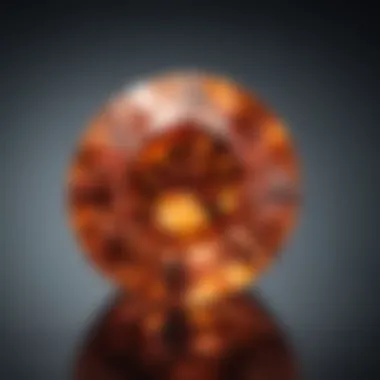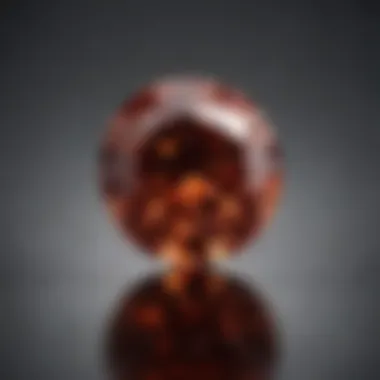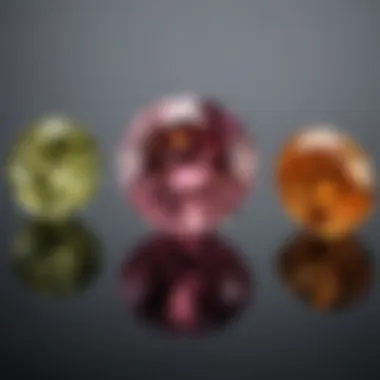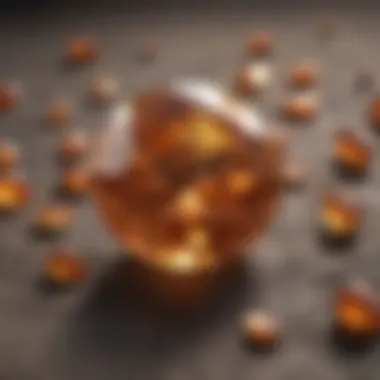Zircon Price per Carat: Comprehensive Analysis


Intro
Zircon, often overshadowed by its more famous cousins like diamond or ruby, is a gemstone that packs a punch when it comes to beauty and value. Those exploring the gemstone market might be curious about how the price of zircon is determined, especially when they consider factors like its qualities, treatments, and source. This article aims to dive deep into the economic nuances of zircon, focusing specifically on the price per carat, shedding light on what influences these values.
Understanding the pricing of zircon isn’t merely about looking at numbers; it requires delving into the variables that swirl around, affecting market trends and consumer decisions. From the sparkle that draws in the eye to the ethical implications of its sourcing, every aspect plays a significant role in its market worth.
In the sections that follow, we will navigate through an array of topics, including the defining characteristics of zircon, the broader spectrum of gemstones, and the chemical and physical properties that set zircon apart from others. Furthermore, we’ll dissect the elements influencing demand and how market fluctuations shape the value of zircon.
Let’s begin this journey by establishing a solid foundation with an overview of zircon as a gemstone.
Understanding Zircon
When we embark on the subject of zircon gemstones, it's essential to grasp not just their beauty but the intricate web of factors that tie them to their valuation in the market. An informed understanding of zircon lays the groundwork for deeper insights into its price dynamics, demand, and overall market behavior. This section serves as the launching pad for a well-rounded discussion on zircon pricing, helping enthusiasts, collectors, and industry professionals alike appreciate why this charming stone holds its place in the world of gems.
What is Zircon?
Zircon is often misunderstood. Commonly mistaken for the synthetic cubic zirconia, it stands apart as a naturally occurring mineral. Chemically, zircon is a zirconium silicate, with its formula being ZrSiO4. It varies in color from blue to yellow, green, and even colorless. Its brilliance rivals that of diamonds due to its high refractive index, making it more than just a geological curiosity. Its toughness ensures that it holds up well in jewelry, while its affordability makes it accessible, further enhancing its appeal.
The stone's versatility leads to diverse applications, from wearables like rings and necklaces to decorative pieces in high-end jewelry collections. Understanding these aspects brings into focus why its pricing can fluctuate widely.
Historical Significance of Zircon
The significance of zircon dates back thousands of years. In many ancient cultures, it was revered for its supposed protective qualities. For example, in the Middle Ages, zircon was believed to promote sleep and ward off evil spirits. Its presence in royal adornments underscores its esteem.
Not only was zircon valued as a gemstone, but it also served a role in the world of science. Archaeologists have utilized zircon crystals to date rocks and determine the Earth's age. This multifaceted importance, both cultural and scientific, contributes to the gemstone's legacy, impacting its market perception.
Geological Formation of Zircon
Zircon forms under conditions that span across a wide range of environments, but primarily within igneous rocks. It forms through magma cooling, settling in layers as temperatures drop. This natural process involves immense pressure and heat in Earth's crust, leading to formation that could take millions of years. It can also be found in sedimentary rocks through weathering over time.
In terms of geographic distribution, zircon deposits are found across the globe, from Australia to Africa and North America. This widespread presence generates a vast diversity of zircon types, each with its unique characteristics, influencing supply and, consequently, market prices. Understanding the geological backdrop of zircon enhances one's awareness of the deeper aspects that influence its value in today’s market.
Factors Influencing Zircon Pricing
Understanding what drives the price of zircon is crucial for gemstone enthusiasts and collectors alike. Several elements collectively dictate the overall market price. These include quality, carat weight, and even the pulse of the market, influenced by demand and supply dynamics. All these components weave together to form a tapestry that ultimately defines the worth of this stunning gemstone.
Quality Assessment of Zircon
Every gemstone carries a unique fingerprint of quality, and zircon is no exception. When it comes to assessing zircon, there are three primary characteristics to consider:
Color
Color plays a pivotal role in determining the allure of zircon. Available in a range of hues from colorless to shades of blue, green, and even red, each color has its unique charm. The vibrancy of the blue zircon, for instance, often makes it a preferred choice among collectors. The deeper the saturation, the higher the price tends to be.
Notably, certain colors are rarer than others. For example, vivid blue zircon tends to fetch a premium due to its scarcity in the market. However, the intensity of color can also detract from the stone's value; overly dark or dull shades might not command the same respect.
"Color can make or break a gemstone’s appeal, and zircon is no different."
Clarity
Clarity speaks to the transparency and absence of inclusions in zircon. A clear stone is more desirable than one that features noticeable flaws. When a gem is free from blemishes, it captures light beautifully, enhancing its luster and brilliance.


Zircon's inherent properties can sometimes make clarity less of an issue than with other gems such as diamonds. Still, a flawless stone is particularly valuable for collectors who appreciate the intricacies that clarity brings. The challenge lies in the delicate balance; a stone that is too perfect might be over-polished, losing its natural beauty.
Cut
Cut refers to how the stone has been shaped and faceted. A high-quality cut can bring out the full potential of a zircon, reflecting light in an enchanting way. Expert craftsmanship creates stones that not only look stunning but also maximize carat weight.
In contrast, a poorly cut stone can appear dull and lifeless, even if it’s of good color and clarity. Therefore, the cut influences both the aesthetic appeal and the perceived value of zircon significantly. Collectors often favor not just the appearance, but the skill behind the cutting process.
Carat Weight and Its Implications
When it comes to gemstones, carat weight is typically viewed through the lens of value. Larger sizes generally result in higher prices due to their scarcity. However, in the world of zircon, things are not cut and dried. While larger stones can command higher prices, the rarity of premium quality in smaller stones can shift this standard. For instance, a smaller zircon with exceptional color and clarity might surpass that of a larger, less impressive piece. The law of diminishing returns applies here, as the increase in price per carat is not linearly proportional to size.
Market Demand and Supply
The market for zircon fluctuates like the tide, influenced by various factors including trends in jewelry design and evolving consumer preferences. Zircon has received increased attention as an alternative to diamond in certain markets, which can drive prices upward. Seasonal trends can also impact availability; for example, demand traditionally spikes during festive seasons or wedding periods.
Another noteworthy point in this equation is the sourcing of zircon. Ethical sourcing practices are increasingly important in today’s market, influencing supply chains and potentially affecting pricing. As consumers become more environmentally conscious, the demand for ethically sourced gemstones can elevate prices for those that meet these criteria.
Comparative Analysis of Zircon with Other Gemstones
In the world of gemstones, zircon often finds itself overshadowed by its more illustrious counterparts. However, understanding how zircon stacks up against other gems is crucial, not only for enthusiasts but also for collectors and designers. This section delves into the comparative analysis of zircon with other well-known gemstones, shedding light on their intrinsic qualities and market dynamics.
Zircon vs. Diamond
Price Comparison
When one thinks of gemstones, diamonds immediately spring to mind. The price comparison between zircon and diamond serves as a pivotal point in understanding the market worth of zircon. Diamonds are often seen as the pinnacle of luxury, commanding prices that can reach astronomical figures, particularly for high-quality specimens. In contrast, zircon, with vibrant colors and unique luster, usually sits at a much lower price point. For instance, while a high-quality diamond can easily be priced at several thousand dollars per carat, a comparable zircon may only range from a few hundred to a couple thousand, depending on its clarity and color.
This price comparison is significant for buyers looking for beauty without breaking the bank. Many consider zircon an attractive alternative, offering similar brilliance without the hefty price tag. However, it's essential to note that while zircon provides excellent value, it lacks the same cultural cache attached to diamonds, which can influence a buyer's decision.
Market Perception
Market perception of zircon versus diamond paints a picture of contrast. Diamonds are often referred to as a symbol of wealth and commitment, driven by decades of marketing and societal norms. Zircon, on the other hand, exists in a quasi-obscure realm, often confused with cubic zirconia, which can dilute its value in the eyes of the uninformed consumer.
However, those in the know recognize that natural zircon possesses a distinct aesthetic and comes with a rich history of value. The unique color variations of zircon, ranging from blue to red, provide a visual allure that captivates many. The market perception of zircon may not elevate it to the iconic status of diamonds, yet its growing popularity among artisans and ethical buyers is beginning to shift this narrative.
Zircon vs. Cubic Zirconia
Quality Distinction
When comparing zircon to cubic zirconia, the quality distinction emerges as a fundamental aspect to highlight. Cubic zirconia, being synthetic, lacks the natural origins of zircon, which is derived from the Earth's crust. Zircon has a unique crystal structure and offers an incredible range of colors. Its quality is often judged based on its clarity and cut, often displayed in exquisite jewelry settings. Cubic zirconia, while visually appealing and more affordable, does not possess the same depth or character that natural zircon can offer.
The quality distinction between the two can sway many buyers towards zircon for its authenticity and rarity. While cubic zirconia can serve as a viable substitute for more casual settings, serious collectors often prefer period pieces featuring genuine gemstones like zircon due to their intrinsic value.
Value Differences
Value differences between zircon and cubic zirconia also play a critical role in the comparative analysis. Although cubic zirconia is frequently touted for its low cost, it can lack the market longevity associated with natural stones. While the initial investment in cubic zirconia may seem appealing, it does not appreciate in value the way genuine gemstones do over time.
For someone seeking an investment piece or a unique gift, zircon stands out. Its appreciation potential, particularly in high-quality specimens, positions it as a valuable option in the market. Unlike cubic zirconia, which is widely produced, natural zircon offers a limited supply, potentially increasing its desirability and price in the long run.
Zircon vs. Other Natural Gemstones
Emerald


Emeralds, revered for their lush green hue, are undoubtedly a stunning option that captures the hearts of many gemstone enthusiasts. However, when looking at emeralds compared to zircon, we find that emeralds often carry a higher price tag due to their rarity and demand. The deep greens of emeralds are due to chromium, whereas the captivating colors of zircons can range from blue to yellow to even colorless. While emeralds evoke a sense of royal elegance, zircon provides versatility at a relatively accessible price.
Emeralds may entice those seeking vibrancy and historic value, but for buyers looking for something different yet striking, zircon becomes an appealing alternative.
Ruby
Rubies, known for their intense red color, often rival diamonds in terms of desirability. When comparing rubies to zircon, the latter may lack strong recognition but holds its ground with beautiful warm tones. Rubies can carry sky-high prices, particularly for those with deep color saturation and minimal inclusions. Zircon, although typically less expensive, offers a plethora of colors and more varied characteristics. The value of rubies shines through in high-end settings, but as with emeralds, zircon presents an attractive option that doesn't demand the same commitment financially.
Sapphire
Sapphires, celebrated for their blues and other hues, add another layer to the comparative analysis. For sapphire aficionados, the desire for top-quality stones usually drives prices sky-high. However, zircon, when in gemstone form, provides remarkable clarity and vivid coloration that can mimic sapphires at a fraction of the cost. This allows buyers to enjoy the aesthetic without the often overwhelming expenses associated with high-grade sapphires.
Market Trends for Zircon Pricing
Understanding the market trends for zircon pricing is crucial for anyone involved in the gemstone industry—whether you are a collector, jeweler, or simply an enthusiast. Analyzing these trends is like putting on a pair of spectacles that allow one to see the intricate details of zircon's value fluctuations, helping stakeholders make informed decisions. Current trends not only reflect the historical context of price evolution but also give insights into future developments. As the demand for ethical gemstones grows and consumers become more aware of sourcing concerns, the intersection of these factors shapes the medium and long-term market outlook.
Historical Price Evolution
Zircon's pricing has undergone various transformations over decades, influenced by availability, taste trends, and market demand. Historically, prices have ranged widely, fluctuating from relatively low costs to notable spikes during peaks in popularity. For instance, the late 1970s saw an uptick in interest due to increased consumer awareness and visibility in jewelry, which led to higher prices. In contrast, the 1990s experienced a dip as synthetic alternatives captured market share, affecting natural zircon demand.
- Price Dynamics:
- Early interest in zircon grew from its natural brilliance and diverse colors.
- Market saturation of alternatives pushed prices lower.
- The early 2000s brought renewed interest, particularly in colored gemstones, helping restore price levels.
This historical backdrop allows consumers and investors to grasp why zircon prices behave the way they do and what signals to look for in the future.
Current Market Trends
As of now, zircon pricing reflects a curiosity within the market community toward ethical sourcing. There’s a growing trend of responsible consumerism, pushing buyers to inquire about the origins of their gemstones. This has led to a slight increase in prices as ethically produced zircons tend to carry a premium.
Also, online marketplaces provide more exposure for both buyers and sellers, making it easier to gauge market rates.
- Online Influence:
- Platforms like Facebook and Reddit inform buyers about actual market conditions, allowing for quick comparisons.
- Increased accessibility means price transparency that was previously unavailable.
The current demand for zircon is being further buoyed by fashion designers incorporating this gemstone into their lines, emphasizing its unique hues and refraction properties.
Predicted Future Trends
Looking ahead, analysts suggest that zircon pricing will continue to evolve, likely influenced by both market demand and global economic conditions. If the trend toward ethical sourcing strengthens, we could see prices rise further as more consumers seek out responsibly sourced gems.
Moreover, the growing popularity of mineral education can play a significant role in stimulating interest and, consequently, prices. New entrants who learn about the unique characteristics of zircon might be willing to invest more as they recognize its intrinsic value.
- Future Predictions:
- An increase in certified ethical sources could fortify prices globally.
- Continued marketing efforts in the gemstone sector can highlight zircon's advantages over other stones.
An increase in ethical awareness could very well drive the gemstone market towards more sustainable practices while positively impacting zircon's pricing structure.
The Role of Ethical Sourcing in Pricing
Understanding the role of ethical sourcing in pricing zircon has become increasingly important in today’s market. As consumers grow more conscious about the origins of their purchases, the ways in which gemstones are sourced can significantly affect their value and desirability. Ethical sourcing, encompassing various practices aimed at ensuring that gemstones are obtained in a responsible manner, has a ripple effect on openness and trust in the industry.


A significant aspect of ethical sourcing is the way it influences consumer perception. Buyers, especially those who consider themselves socially responsible, often prefer gemstones that can be traced back to morally sound origins. This preference can lead to higher prices for ethically sourced zircons. It’s like they say, “You get what you pay for,” where ethical practices align with higher quality assurance.
What is Ethical Sourcing?
Ethical sourcing refers to the practice of obtaining gemstones with consideration for environmental sustainability and social responsibility. This concept extends beyond the transaction itself, incorporating aspects such as labor practices, environmental impact, and community welfare. Essentially, it emphasizes transparency, ensuring that the suppliers adhere to defined ethical standards.
A few key elements typically included in ethical sourcing are:
- Fair Labor Practices: Ensuring workers are treated fairly, receive fair wages, and work in safe conditions.
- Environmental Stewardship: Minimizing environmental damage during the extraction process, employing sustainable practices to preserve ecosystems.
- Transparency: Providing buyers with clear information about where and how the gemstones are sourced.
By adopting these principles, companies can foster a positive reputation, which can ultimately lead to better pricing for their products.
Impact on Zircon Valuation
The impact of ethical sourcing on zircon valuation can be profound. Here are several ways in which ethical considerations can affect prices:
- Increased Demand: More consumers are now on the lookout for ethically sourced gemstones. If a zircon is verifiably sourced ethically, it often garners a higher price tag.
- Brand Loyalty: Companies that practice ethical sourcing tend to cultivate a loyal customer base. Buyers are inclined to support brands that align with their values, which can translate to consistent sales and potentially elevate the pricing.
- Market Differentiation: As the market becomes saturated with various gemstone options, ethical sourcing serves as a way to stand out. Zircons that carry an ethical designation can command premium prices, distinguishing them from lower-priced alternatives.
Evaluating Zircon's Value Beyond Price
When considering Zircon, it's easy to get lost in the numbers, focusing solely on carat weight and price fluctuations. However, evaluating zircon's worth entails much more than just its monetary value. Several layers contribute to its overall perception and demand in the market. Delving into the aesthetic, metaphysical, and cultural worth of zircon can illuminate its significance beyond pricing. This approach allows buyers and collectors to connect with zircon on a personal level, appreciating its unique qualities that go far beyond the mere cost per carat. Understanding these multifaceted dimensions can also lead to more informed decisions when purchasing this captivating gemstone.
Aesthetic and Metaphysical Considerations
Zircon is widely admired for its visual appeal. Available in a rainbow of colors, from deep blues to rich reds, it can easily catch the eye. The brilliance and fire that zircon exhibits often rival those of more expensive stones, drawing in buyers looking for beauty and elegance. The way light dances through a well-cut zircon can evoke emotions that go deeper than surface value—a simple glance at a well-crafted piece of jewelry might evoke nostalgia or a sense of calm.
In the realm of metaphysics, zircon holds various significances. People often regard it as a stone of wisdom and wealth, believed to enhance personal development and luck. Some even think it has protective qualities, offering a form of guidance. This isn’t just folklore; many enthusiasts and collectors treasure their pieces not only for their beauty but also for these supposed benefits. Thus, each stone tells a story and connects to the wearer's journey, adding layers of worth that can’t be quantified strictly by price.
Cultural and Symbolic Significance
Zircon has found its place in multiple cultures around the globe, making it more than just a gemstone. In many traditions, it symbolizes strength and valor. Historically, it has been associated with various religious and ceremonial uses. In ancient times, it was believed to possess healing properties, with some cultures using it in potions and remedies.
Furthermore, the diverse colors of zircon often carry different meanings in various cultures. For example, blue zircon might represent tranquility in one tradition, while red zircon could symbolize passion in another. This rich tapestry of symbolism amplifies its significance, making zircon a thoughtful gift or heirloom that carries weight beyond its market value.
"Jewelry isn't just about adornment; it's about storytelling and connection to our roots."
Epilogue and Future Directions
In wrapping up our thorough exploration of zircon pricing, it becomes clear that understanding these financial dynamics is crucial for enthusiasts and professionals alike. The journey through the intricacies of zircon pricing reveals not just numbers, but a tapestry of various influences—quality factors, market demand, and ethical sourcing, to name a few.
As buyers and collectors venture into the world of zircon gemstones, keeping abreast of changing market trends, from historical shifts to anticipated future directions, can significantly impact their investments. With gemstones like zircon, which is sometimes viewed through the lens of rarity and uniqueness, the future might hold exciting developments influenced by sustainable mining practices and the evolving tastes of consumers.
Key Takeaways:
- Positioning oneself with a solid knowledge base regarding the market will often yield advantages when purchasing.
- Staying informed about ethical sourcing can distinguish between a substantial investment and one that's merely superficial.
- Understanding the varying factors influencing prices cultivates an environment for informed decision-making.
Summary of Insights
Reflecting upon the data provided in the previous sections, several insights can be drawn that underline the value of zircon in today's market. Firstly, price is justified by quality—a higher-quality zircon typically commands a better price per carat, factoring in vivid color, clarity, and expert cut. Furthermore, historical data showcases a steady interest in this stone, particularly with the trend toward ethical sourcing gaining traction in recent times.
Additionally, it is noteworthy that zircon, while often compared to diamonds or cubic zirconia, offers a different, often more appealing allure due to its broader color spectrum and substantial market presence that drives ongoing interest.
Recommendations for Buyers and Collectors
For those eager to invest in zircon or simply expand their collections, the following recommendations may prove beneficial:
- Do your homework: Research and understand the differences between natural and treated zircon. Treatment can affect value quite significantly.
- Evaluate quality: Always assess the quality factors—color, clarity, and cut—before making any purchasing decisions.
- Engage knowledgeable suppliers: Whether it's an online retailer or a local jeweler, ensure you are working with reputable professionals who can provide insights into the stones' origins and treatments.
- Stay alert to market changes: Regularly check prices and market conditions to recognize potential opportunities. Understanding market fluctuations can help make smarter investments.
- Consider future trends: As consumer preferences shift towards ethically sourced gemstones, look for sellers who prioritize transparency in their operations.
In a nutshell, the world of zircon is both fascinating and intricate, filled with endless potential for those willing to delve deep into its nuances. As the market evolves, so may your approach to navigating this gem's value.



